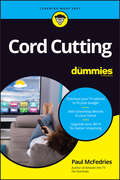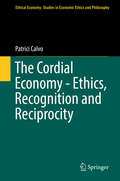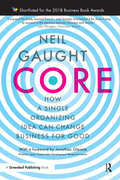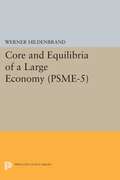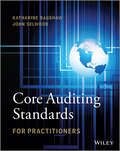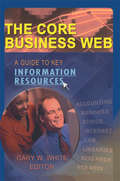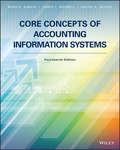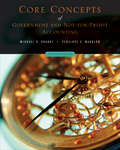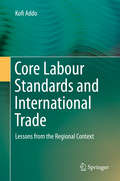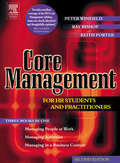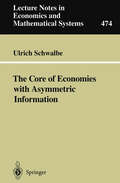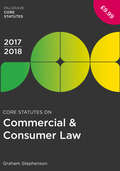- Table View
- List View
Cord Cutting For Dummies
by Paul McFedriesCut the cable television cord and cut your monthly bills Are you one of those people who have 500 television channels to choose from and you can never find anything to watch? Maybe it’s time to cut the cable cord and take full control of what’s on your television. All you need to get started with this popular money saving strategy is an Internet connection, a device to stream to, and the advice in this book. With Cord Cutting For Dummies, you go from evaluating if cord cutting is the right choice for your budget to acquiring the technology to get the programming you actually want. You’ll discover the technology you need for streaming, select the service or services that fit your needs, and make the components of your setup work together—all within your budget. Cord Cutting For Dummies offers the steps to going from wired to wireless, including: Deciding if you need to upgrade your Wi-Fi equipment and service. Evaluating your current devices. Adding a smart TV to the mix. Choosing the best streaming services for you—including some free options When you’re ready to untether yourself from the cable or satellite, Cord Cutting For Dummies shows you, step by step, how to break free. Pick up a copy and you’ll be watching your favorite movie or TV show in no time!
Cord Cutting For Dummies
by Paul McFedriesCut the cable television cord and cut your monthly bills Are you one of those people who have 500 television channels to choose from and you can never find anything to watch? Maybe it’s time to cut the cable cord and take full control of what’s on your television. All you need to get started with this popular money saving strategy is an Internet connection, a device to stream to, and the advice in this book. With Cord Cutting For Dummies, you go from evaluating if cord cutting is the right choice for your budget to acquiring the technology to get the programming you actually want. You’ll discover the technology you need for streaming, select the service or services that fit your needs, and make the components of your setup work together—all within your budget. Cord Cutting For Dummies offers the steps to going from wired to wireless, including: Deciding if you need to upgrade your Wi-Fi equipment and service. Evaluating your current devices. Adding a smart TV to the mix. Choosing the best streaming services for you—including some free options When you’re ready to untether yourself from the cable or satellite, Cord Cutting For Dummies shows you, step by step, how to break free. Pick up a copy and you’ll be watching your favorite movie or TV show in no time!
The Cordial Economy - Ethics, Recognition and Reciprocity (Ethical Economy #55)
by Patrici CalvoThis book proposes, from a civil perspective —such as that developed by Stefano Zamagni— and a cordial perspective —such as that developed by Adela Cortina—, orientations to design an economy in tune with what the historical moment demands. Among other things, this comes from encouraging institutions, organisations and companies to include in their designs aspects as important for carrying out their activities as cordial reciprocity, mutual recognition of the communicative and affective capacities of the linked or linkable parties, public commitment and the active participation of civil society.The book first shows the conceptualisation of the process of self-interest as operating for one’s own benefit and its inclusion in the orthodox economic model. In Chapter 2 it then displays some of the logical/formal and experimental limits of the axiomatic economics model to discover the possibility of building bridges between theoretical modelling and factual validation. Chapter 3 demonstrates the fragility of a rationality model based on the paradigmatic figure of homo oeconomicus. Chapter 4 reflects on the critical process that has identified reciprocity as a determining factor for human cooperation, turning this behaviour into a paradox in which the lack of a reasonable explanation from the selfish perspective becomes inconsistent in the predominant economic theory. Chapter 5 is from a moral point of view it describes and criticises the different approaches to reciprocity observed by sociologists, biologists, psychologists and economists. Chapter 6 analyses three mutual recognition proposals as possible foundations for human cooperation, highlighting one of them –cordial recognition, developed by Cortina– because it is more closely related to studies of reciprocity, particularly the most recent contributions from the neurosciences. Chapter 7 proposes cordial reciprocity as a horizon of meaning for the various approaches to reciprocity observed. Chapter 8 explores the possible emergence and development of cordial goods, a type of relational and communicative good that enables joint actions to take place in different contexts of human activity. Chapter 9 analyses the application and implementation of cordial reciprocity at the macro, meso and micro levels of the economy. And finally, it proposes guidelines for designing a monitoring and compliance system which, based on the communication, storage and processing of big data and the committed participation of stakeholders, offers businesses the possibility of inspecting their underlying dimensions of morality, emotions and responsibility.
The Cordon Sanitaire
by Ali KadriThis work compares the development experiences of East Asia and the Arab world. It posits that in view of the collapse in socialism and its ideological retreat, their development performances are intensely over determined by their modes of integration with world capital. For East Asia, it's through manufacturing of civilian-end use commodities and for the Arab World, through militarism. The book is a unique attempt approaching the topic from the theoretical angle using an analytical comparative perspective.
The Cordon Sanitaire: A Single Law Governing Development in East Asia and the Arab World (PDF)
by Ali KadriThis work compares the development experiences of East Asia and the Arab world. It posits that in view of the collapse in socialism and its ideological retreat, their development performances are intensely over determined by their modes of integration with world capital. For East Asia, it's through manufacturing of civilian-end use commodities and for the Arab World, through militarism. The book is a unique attempt approaching the topic from the theoretical angle using an analytical comparative perspective.
Corduroy (A rural trilogy #1)
by Adrian BellCorduroy was first published in 1930. It was followed by Silver Ley in 1931 and The Cherry Tree in 1932. Together they form a trilogy that has been described as 'the classic account of a twentieth-century Englishman's conversion to rural life'. In Corduroy the author's experiences as a farm apprentice in Suffolk are described. The tone is affectionate, humourous and not in the least patronizing. At times there is an elegiac strain not dissimilar to Edward Thomas. The three books constitute a threnody for, what was then, a vanishing, pre-mechanized way, of farming and rural life.
CORE: How a Single Organizing Idea can Change Business for Good
by Neil GaughtCORE is shortlisted for the Best Business Book Awards in the Engaging Change category. At the core of the world's most admired businesses lies a powerful Single Organizing Idea. These organizations deliver sustainable economic and social benefit; they unite people, attract investment, inspire innovation, pioneer new efficiencies, and enjoy positive reputation. Such businesses are admired but they remain a rare breed. Though the tides of change are engaging the minds of business leaders, most are still trapped behind their brands and an approach to corporate social responsibility that is out of step with a connected society that increasingly questions 'who' these businesses really are and what drives their purpose. This book is about how businesses can adopt a Single Organizing Idea and, more importantly, why they have to. Drawing on stories and case studies, and with reference to the UN's Sustainable Development Goals, its no-nonsense approach sets aside the ideals to confront the realities of business reform. It demonstrates the power and potential that a Single Organizing Idea can bring to any business prepared to take its head out of the sand and proactively respond to today's challenges.
CORE: How a Single Organizing Idea can Change Business for Good
by Neil GaughtCORE is shortlisted for the Best Business Book Awards in the Engaging Change category. At the core of the world's most admired businesses lies a powerful Single Organizing Idea. These organizations deliver sustainable economic and social benefit; they unite people, attract investment, inspire innovation, pioneer new efficiencies, and enjoy positive reputation. Such businesses are admired but they remain a rare breed. Though the tides of change are engaging the minds of business leaders, most are still trapped behind their brands and an approach to corporate social responsibility that is out of step with a connected society that increasingly questions 'who' these businesses really are and what drives their purpose. This book is about how businesses can adopt a Single Organizing Idea and, more importantly, why they have to. Drawing on stories and case studies, and with reference to the UN's Sustainable Development Goals, its no-nonsense approach sets aside the ideals to confront the realities of business reform. It demonstrates the power and potential that a Single Organizing Idea can bring to any business prepared to take its head out of the sand and proactively respond to today's challenges.
Core and Equilibria of a Large Economy. (PSME-5) (PDF)
by Werner HildenbrandCan every allocation in the core of an economy be decentralized by a suitably chosen price system? Werner Hildenbrand shows that the answer is yes if the economy has "many" participating agents and if the influence of every individual agent on collective actions is "negligible." To give a general and precise definition of economics with this property he considers both economies with a continuum of agents, and a sequence of economies with an increasing number of participants. In both cases this leads to a measure theoretic formulation of economic equilibrium analysis.In the first part of the book the relevant mathematics is developed. In the second part the continuity and convexity properties of the total demand of a consumption sector are investigated. An important result is the equivalence between the core and the set of Walras equilibria for an exchange economy with a continuum of agents. The author then deals with limit theorems on the core for purely competitive sequences of exchange economies. In the last chapter the core and the set of Walras equilibria for a coalition production economy and the relation between these two equilibrium concepts are studied.Originally published in 1974.The Princeton Legacy Library uses the latest print-on-demand technology to again make available previously out-of-print books from the distinguished backlist of Princeton University Press. These editions preserve the original texts of these important books while presenting them in durable paperback and hardcover editions. The goal of the Princeton Legacy Library is to vastly increase access to the rich scholarly heritage found in the thousands of books published by Princeton University Press since its founding in 1905.
Core Auditing Standards for Practitioners: For Practitioners
by Katharine Bagshaw John SelwoodThe only book on the market specifically designed to help audit staff stay ahead of inspectors This comprehensive, practical, and theoretical guide covers the key ISAs that underpin audit methodologies and the recently revised ISAs that cause practitioners the most concern. It is designed to enhance auditors' understanding of critical ISAs, reducing their dependence on methodologies to mediate and explain ISA requirements. Using plenty of examples, the book helps audit staff learn to tailor audit methodologies and remove redundancies, as well as form high-quality judgments with a thorough grounding in ISA to serve in discussions with file reviewers and audit inspectors. Features practical examples that appeal to auditors with technical responsibilities Covers key topics such as smaller audits, management override of controls, documenting judgments, and dealing with accounting estimates and written presentations Ideal for practitioners in companies and accounting firms, as well as auditing students Includes access to a companion website with constantly updating ISAs and case studies Mixing theory with practical examples, Core Auditing Standards for Practitioners provides experienced audit staff with key ISA-related information they need to succeed.
Core Auditing Standards for Practitioners: For Practitioners
by Katharine Bagshaw John SelwoodThe only book on the market specifically designed to help audit staff stay ahead of inspectors This comprehensive, practical, and theoretical guide covers the key ISAs that underpin audit methodologies and the recently revised ISAs that cause practitioners the most concern. It is designed to enhance auditors' understanding of critical ISAs, reducing their dependence on methodologies to mediate and explain ISA requirements. Using plenty of examples, the book helps audit staff learn to tailor audit methodologies and remove redundancies, as well as form high-quality judgments with a thorough grounding in ISA to serve in discussions with file reviewers and audit inspectors. Features practical examples that appeal to auditors with technical responsibilities Covers key topics such as smaller audits, management override of controls, documenting judgments, and dealing with accounting estimates and written presentations Ideal for practitioners in companies and accounting firms, as well as auditing students Includes access to a companion website with constantly updating ISAs and case studies Mixing theory with practical examples, Core Auditing Standards for Practitioners provides experienced audit staff with key ISA-related information they need to succeed.
The Core Business Web: A Guide to Key Information Resources
by Gary W WhiteThe best Business Web sites at your fingertips-24/7! The Core Business Web: A Guide to Key Information Resources is an essential resource that saves you from spending hours searching through thousands of Web sites for the business information you need. A distinguished panel of authors, all active in business librarianship, explores Web sites in their subject areas, selecting the very best from 25 functional areas of business. Each site was chosen based on the timeliness, relevance and reliability of its content, the site's ease of navigation and use, and the authority of the site's author or publisher. The rapid growth of the Internet has resulted in an ever-increasing number of Web sites offering potentially useful business information. The Core Business Web identifies, evaluates, and summarizes the most significant sites, including gateways or portals, directories, and meta-sites, to organize online resources into easy-to-follow links that allow you to access information quickly. Sites are categorized and listed for 25 areas of business, including: banking-commercial banking, regulators, trade associations, international links business law-statutes, regulations, decisions, antitrust, corporations, international transactions, labor and employment, tax and taxation, uniform commercial code career information and salary surveys-labor statistics, job hunters, career planning e-commerce-e-business news, statistics, "how-to" sites, technology sites, business-to-business sites finance and investments-market analysis and commentary, market news, stock screeners, brokers hospitality and tourism-lodging and gaming, restaurant and foodservice small business and entrepreneurship-startup information, counseling, funding and venture capital, and sites for women and minority-owned businesses, and much more! The Core Business Web is an invaluable resource for saving valuable time that's intended for information professionals but can be used by anyone seeking business information online.
The Core Business Web: A Guide to Key Information Resources
by Gary W WhiteThe best Business Web sites at your fingertips-24/7! The Core Business Web: A Guide to Key Information Resources is an essential resource that saves you from spending hours searching through thousands of Web sites for the business information you need. A distinguished panel of authors, all active in business librarianship, explores Web sites in their subject areas, selecting the very best from 25 functional areas of business. Each site was chosen based on the timeliness, relevance and reliability of its content, the site's ease of navigation and use, and the authority of the site's author or publisher. The rapid growth of the Internet has resulted in an ever-increasing number of Web sites offering potentially useful business information. The Core Business Web identifies, evaluates, and summarizes the most significant sites, including gateways or portals, directories, and meta-sites, to organize online resources into easy-to-follow links that allow you to access information quickly. Sites are categorized and listed for 25 areas of business, including: banking-commercial banking, regulators, trade associations, international links business law-statutes, regulations, decisions, antitrust, corporations, international transactions, labor and employment, tax and taxation, uniform commercial code career information and salary surveys-labor statistics, job hunters, career planning e-commerce-e-business news, statistics, "how-to" sites, technology sites, business-to-business sites finance and investments-market analysis and commentary, market news, stock screeners, brokers hospitality and tourism-lodging and gaming, restaurant and foodservice small business and entrepreneurship-startup information, counseling, funding and venture capital, and sites for women and minority-owned businesses, and much more! The Core Business Web is an invaluable resource for saving valuable time that's intended for information professionals but can be used by anyone seeking business information online.
Core Concepts of Accounting Information Systems
by Mark G. Simkin James L. Worrell Arline A. SavageAccounting Information systems (AIS) have become indispensable in the field, and this book provides clear guidance for students or professionals needing to get up to speed. Designed to suit a one-semester AIS course at the graduate, undergraduate, or community college level, Core Concepts of Accounting Information Systems explores AIS use and processes in the context of modern-day accounting. Coverage includes conceptual overviews of data analytics, accounting, and risk management, as well as detailed discussion of business processes, cybercrime, database design and more to provide a well-rounded introduction to AIS. Case studies reinforce fundamental concepts using real-world scenarios that encourage critical thinking, while AIS-at-Work examples illustrate complex procedures or concepts in everyday workplace situations. Test Yourself questions allow students to gauge their level of understanding, while End of Chapter questions stimulate application of new skills through problems, cases, and discussion questions that facilitate classroom dialogue. Practical, current, relevant, and grounded in everyday application, this book is an invaluable resource for students of managerial accounting, tax accounting, and compliance.
Core Concepts of Government and Not-For-Profit Accounting
by Michael H. Granof Penelope S. WardlowBuilding on the success of Government and Not-For-Profit Accounting, 2/e, Michael Granof and Penelope Wardlow’s new text, CORE CONCEPTS OF GOVERNMENT AND NOT-FOR-PROFIT ACCOUNTING presents a concise, accessible, user-oriented look at the unique features of governmental and not-for-profit accounting. The text helps students understand the “why” of accounting requirements and how financial statements may be interpreted and used by a variety of interested parties, such as future managers, bond analysts, and members of legislatures and governing boards.
Core Labour Standards and International Trade: Lessons from the Regional Context
by Kofi AddoThis book examines the labour standards provisions in a number of Regional and Bilateral Trade Agreements, and assesses the potential of using the relevant clauses in these trade agreements as a benchmark for a multilateral approach. Based on the lessons learned from the Regional model, the book proposes a Global Labour and Trade Framework Agreement (GLTFA) combined with a joint ILO/WTO enforcement mechanism to resolve the contentious issue of the link between the CLS and international trade. The history of the linkage between the Core Labour Standards (CLS) and international trade dates back roughly 150 years, and has recently become one of the most vexing issues facing policy-makers. At the heart of the debate is the question whether or not trade sanctions should be imposed on countries that do not respect the CLS as embodied in multilateral conventions administered by the International Labour Organization (ILO). Concretely, this would entail inserting a social clause in the World Trade Organization (WTO) rules, and would trigger the imposition of sanctions on those countries that do not adhere to the CLS.
Core Management for HR Students and Practitioners
by Peter Winfield Ray Bishop Keith PorterThis is the second edition of the successful text published in 2000.The text continues to include self- assessment exercises, exam question, further reading and research and uses short case studies and articles to relate theory to practice.The new edition is completely up-dated with more extracts from Personnel Today and linked in to a website provided by the authors. The book provides excellent coverage of the CIPD syllabus for three core areas of the CIPD syllabus, Managing People, Managing Activities and Managing a business context. New end of chapter website links are included.
Core Management for HR Students and Practitioners
by Peter Winfield Ray Bishop Keith PorterThis is the second edition of the successful text published in 2000.The text continues to include self- assessment exercises, exam question, further reading and research and uses short case studies and articles to relate theory to practice.The new edition is completely up-dated with more extracts from Personnel Today and linked in to a website provided by the authors. The book provides excellent coverage of the CIPD syllabus for three core areas of the CIPD syllabus, Managing People, Managing Activities and Managing a business context. New end of chapter website links are included.
The Core of Economies with Asymmetric Information (Lecture Notes in Economics and Mathematical Systems #474)
by Ulrich Schwalbeand should therefore constitute a part of every area of economic 3 theory. The spectrum covered by information economics today ranges from Stigler's search theory4 to industrial economics, including oligopoly theory, innovation, as well as research and develop 5 ment. However, the area information economics is most closely connected with is the theory of optimal contracts, mainly ana 6 lyzed in principal-agent models. Contract theory deals primar ily with the question of how optimal arrangements (contracts) for the purchase and sale of commodities and services between two or more agents should be structured. In these models, it is often assumed that the parties to the contract are informed differently or asymmetrically about relevant variables (e. g. the health of one party in the case of insurance contracts, or the effort in relation to employment contracts). As a result of this asymmetric in formation, phenomena such as moral hazard, adverse selection, signaling, and screening may arise. Frequently, results from con tract theory are referred to when making statements about the effects of asymmetric information on an economy. Models of this kind are often used to explain phenomena such as fixed wages or unemployment, among others. 7 However, such conclusions must be treated with caution for two reasons. In the first place, in these models, a contract (explicit or implicit) is determined by the solution of an optimization prob lem.
The Core-Periphery Divide in the European Union: A Dependency Perspective
by Rudy WeissenbacherThis book revisits the forgotten history of the 'European Dependency School' in the 1970s and 1980s, explores core-periphery relations in the European integration process and the crises of the contemporary European Union from a dependency perspective, and draws lessons for alternative development paths. Was disintegration of the European Union foretold? With the benefit of hindsight, the critical analysis of the European integration process by researchers from the 'European Dependency School' is most timely. The current framework of the European Union seems to be haunted by issues that had been very familiar to the researchers of the 'European Dependency School', such as a lack of a common and balanced industrial policy. How do the situations compare? What lessons can be learnt for alternative development policies in contemporary Europe? Weissenbacher tackles these issues, which are of relevance to all interested in political economy, political science, development studies and regional development.
Core-Periphery Patterns across the European Union: Case Studies and Lessons from Eastern and Southern Europe(PDF)
by Professor Adelaide Duarte Professor Gabriela Carmen PascariuThe EMU debt crisis that emerged in 2010 has identified a group of Southern countries, especially Greece, Portugal, Spain and Italy, as low performers exhibiting several serious macroeconomic imbalances, and it has also highlighted that EU integration experienced by Eastern European countries (especially the latter-comers to EU) was not accompanied by a rapid process of real convergence. Since then, the research about the effects of peripherality have regained a renewed interest to ultimately ground better regional policy recommendations aimed at achieving a sustained reduction of income per capita disparities across EU regions. In this new work, Pascariu and Duarte, along with an international group of acclaimed scholars, delve into key challenges currently facing the European Union. They investigate this central question: does the domestic market system lead to the development of a center-periphery model, by highlight gaps, or does it support the convergence process? Analyzing the effects of peripherality across the EU regions, a two-fold approach is used to deliver policy recommendations grounded in economic theory, and of interest to other countries and regions facing a process of integration.
Core-Periphery Patterns across the European Union: Case Studies and Lessons from Eastern and Southern Europe
by Professor Adelaide Duarte Professor Gabriela Carmen PascariuThe EMU debt crisis that emerged in 2010 has identified a group of Southern countries, especially Greece, Portugal, Spain and Italy, as low performers exhibiting several serious macroeconomic imbalances, and it has also highlighted that EU integration experienced by Eastern European countries (especially the latter-comers to EU) was not accompanied by a rapid process of real convergence. Since then, the research about the effects of peripherality have regained a renewed interest to ultimately ground better regional policy recommendations aimed at achieving a sustained reduction of income per capita disparities across EU regions. In this new work, Pascariu and Duarte, along with an international group of acclaimed scholars, delve into key challenges currently facing the European Union. They investigate this central question: does the domestic market system lead to the development of a center-periphery model, by highlight gaps, or does it support the convergence process? Analyzing the effects of peripherality across the EU regions, a two-fold approach is used to deliver policy recommendations grounded in economic theory, and of interest to other countries and regions facing a process of integration.
Core-Periphery Relations and Organization Studies
by Gavin Jack Robert Westwood Farzad Rafi Khan Michal FrenkelCore-Periphery Relations and Organization Studies draws together postcolonial and indigenous thinking through the conceptual lens of core-periphery relations to advance debate in organization studies. A particular aim of this book is to broaden, deepen and critically reassert a postcolonial imagination in this domain.
Core Statutes on Commercial & Consumer Law 2017-18 (Macmillan Core Statutes)
by Graham StephensonWell-selected and authoritative, Palgrave Core Statutes provide the key materials needed by students in a format that is clear, compact and very easy to use. They are ideal for use in exams.
Core Statutes on Commercial & Consumer Law 2019-20 (Macmillan Core Statutes)
by Graham StephensonWell-selected and authoritative, Macmillan Core Statutes provide the key materials needed by students in a format that is clear, compact and very easy to use. They are ideal for use in exams.
